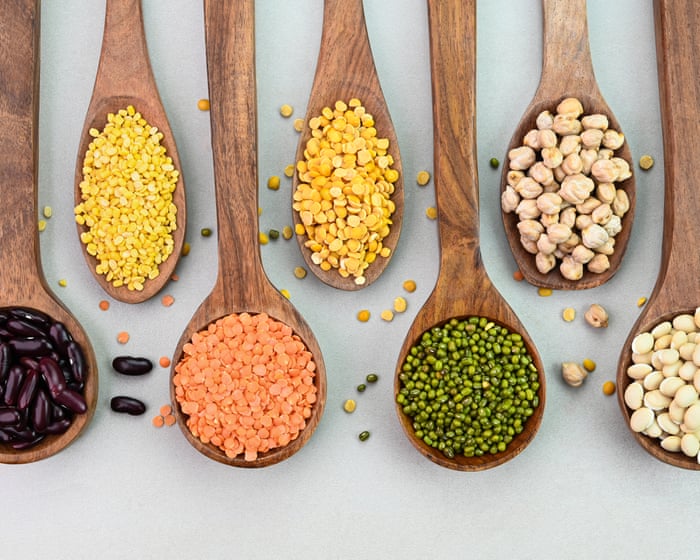Concerned about rising food costs, your diet’s environmental impact, or whether you’re eating well? Believe it or not, the solution might be simple: pulses.
A study from the University of Reading, published in the European Journal of Nutrition in March, found that adults who eat more pulses—like dried beans, peas, and lentils—consume more nutrients, including fiber, folate, vitamins C and E, and minerals like iron, zinc, and magnesium. They also tend to eat less saturated fat and sugar. Similar findings have been reported in research from the U.S., Australia, and Canada.
The UK study also linked pulse consumption to a more sustainable diet. In her book Pulse: Modern Recipes with Beans, Peas & Lentils, Eleanor Maidment explains that growing pulses benefits the environment. “Many pulses are ‘nitrogen fixers,’ meaning they convert atmospheric nitrogen into a form that enriches the soil, making it more fertile for other crops,” she writes. Justine Butler, head of research at Viva!, adds, “Even the lowest-impact beef production generates six times more greenhouse gases and uses 36 times more land per gram of protein compared to peas.”
Pulses are filling, affordable, and nutritious—yet the average British adult eats only about 15g a day, with households spending just £1.68 a week on them. UK dietary guidelines count 80g of pulses (roughly a third of a can) as one of your five daily servings of fruits and vegetables.
The University of Reading study is part of the Raising the Pulse project, which aims to boost pulse consumption for better public and planetary health. One strategy involves adding fava bean flour to white bread—similar to Denmark’s successful use of rye flour to increase whole grain intake. Prof Julie Lovegrove, director of the Hugh Sinclair Unit of Human Nutrition at the University of Reading, says, “These foods are not only nutritious but also incredibly versatile, affordable, and sustainable.”
If you want to eat more pulses, here’s what you should know:
1. No need for long cooking times. “Don’t worry about soaking dried pulses in advance,” says Maidment. “I rarely plan ahead, but thankfully, there are plenty of jarred and canned options that require no prep. If you can splurge a little, jarred varieties often taste better and have a nicer texture—brands like Bold Bean Co, Brindisa, or Belazu are excellent.”
2. Batch-cooking dried pulses saves money. Jenny Chandler, author of Super Pulses and Pulse, recommends soaking and cooking a large batch once a week. “You’ll end up with more than double the volume—it’s a cost-effective way to keep a ready supply. Store them in their cooking water for up to five days in the fridge, or freeze leftovers. Use them in salads, soups, purees, curries, stews, and even desserts—they’ll become a kitchen staple.”
3. Pulses aren’t just for vegetarians. “You don’t have to be vegan or vegetarian to enjoy them,” Maidment says. “We should all eat more pulses. For example, in a traybake, I’ll use one chicken thigh per person instead of two and add a can of chickpeas or butter beans. I also stir lentils into bolognese. You still get filling protein, plus gut-friendly fiber, vitamins, and antioxidants.”
4. They stretch meals further. “Most pulses are inexpensive and mild in flavor, making them perfect for bulking out soups, stews, and curries without altering the taste.”
(Images included in the original text: Broad beans fresh from the pod, dal tadka, and a black bean veggie burger.)Original Flavor
“You can usually swap different types of pulses depending on what you have available,” says Maidment. Chandler likes adding cooked pulses to various dishes. “Tossing chickpeas or cannellini beans into a simple tomato pasta sauce not only boosts nutrition but also keeps you fuller for longer,” she explains.
Beyond Baked Beans
While haricot beans dominate in the UK thanks to baked beans, there’s a whole world of pulses to explore. “Butter beans, cannellini beans, black beans, and kidney beans are popular, but don’t overlook others like flageolet beans—delicate, pale-green beans perfect in a slow-cooked lamb stew with garlic, thyme, and white wine,” Maidment suggests. Chandler is a fan of yin yang beans (also called calypso or orca beans), which she says add beauty and flavor to chili.
But beans on toast still reigns supreme. Joe Yonan, author of Cool Beans, shares his favorite: “Garlicky beans and bitter greens on toast, finished with chili oil.”
Chickpeas: The Ultimate All-Rounder
Yonan calls chickpeas his favorite pulse for their versatility. “They’re the base of hummus, the world’s best dip, and work brilliantly in coronation chickpea sandwiches, salads, and stews.” For a crunchy snack, he roasts them with olive oil and spices (like za’atar or smoked paprika) at 150°C (300°F) for an hour, then lets them cool in the oven for extra crispness. Chickpea flour is another staple—great for farinata (savory pancakes), chickpea fries, or even an untraditional pizza base.
Lentils: Quick and Easy
Lentils cook faster than most pulses, especially red split lentils (ready in about 15 minutes). Soaking isn’t necessary but speeds things up. Maidment enjoys experimenting with different dals, from yellow moong to black urad, each offering unique flavors and textures. She also loves tinned lentils, roasted with olive oil and garlic for a crispy salad topping—perfect with ricotta and prosciutto or tomatoes and mozzarella.
Pulse-Based Dips
While hummus is the classic, Maidment suggests trying other blends, like fava—a Greek yellow pea dip. Blend cooked yellow peas with caramelized onions, garlic, lemon juice, olive oil, and a bit of cooking liquid for a creamy, flavorful spread.
Don’t Waste the Liquid
The liquid from canned pulses (aquafaba) is surprisingly useful. “It adds creaminess to savory dishes or works as an egg substitute in baking,” Maidment says. Just check the label for added salt or preservatives.
Black Bean Burgers
Yonan and Meera Sodha agree: black beans make fantastic veggie burgers. Sodha’s recipe mixes mashed black beans with breadcrumbs, garlic and onion powders, chipotle paste, mustard, ketchup, and aquafaba, shaped into patties and fried until crispy.
British Pulses on the Rise
Maidment and Chandler both recommend carlin peas (also called black badgers), a heritage British pulse making a comeback.Carlin peas are small, nutty brown peas that work well as a chickpea alternative with a similar nutritional boost, according to Maidment. She roasts them until crispy for salads with quinoa, broccoli, and halloumi. Chandler uses them in dips, curries, and even as a refried bean substitute, noting their versatility due to their mild flavor compared to yellow or green peas. In the U.S., Yonan recommends lady peas—small white beans popular in Southern cooking.
Pulses also work well in smoothies. Chandler suggests adding cooked black or borlotti beans to berry blends and chickpeas or butter beans to green smoothies for extra creaminess and nutrition.
Pulse-based pasta, made from pea, lentil, or black bean flour, is another great option. Chandler enjoys it in pasta salads or with bold sauces like blue cheese and walnut, while Yonan pairs it with strong flavors like garlic or spice.
Pulses aren’t just for savory dishes—they shine in desserts too. Yonan makes a chocolate-chickpea tart and adds adzuki beans to brownies, noting their use in Asian sweets like mochi and ice cream. Maidment prefers kidney beans in her brownies, and Chandler whips up a simple chocolate-cannellini bean mousse: blend drained beans with melted dark chocolate and cocoa, then fold in whipped bean liquid (aquafaba) and sweeten with maple or date syrup. Chill before serving with ginger or raspberries.
Would you like to share your thoughts on this topic? You can submit a letter (up to 300 words) for possible publication by clicking here.
FAQS
### **Frequently Asked Questions About *The Power of Pulses: 15 Simple, Tasty Ways to Enjoy More Nutritious Legumes***
#### **Basics & Definitions**
**Q1: What exactly are pulses?**
A: Pulses are the edible seeds of legume plants, such as lentils, chickpeas, beans, and dried peas. They’re packed with protein, fiber, and nutrients.
**Q2: How are pulses different from legumes?**
A: All pulses are legumes, but not all legumes are pulses. Pulses specifically refer to the dried seeds, while legumes include fresh versions.
**Q3: What are some common types of pulses?**
A: Common pulses include lentils, chickpeas, black beans, kidney beans, split peas, and pinto beans.
#### **Health & Nutrition**
**Q4: Why should I eat more pulses?**
A: They’re high in protein, fiber, vitamins, and minerals, support heart health, aid digestion, and help maintain stable blood sugar levels.
**Q5: Are pulses good for weight loss?**
A: Yes! They’re low in fat, high in fiber, and keep you full longer, which can help with weight management.
**Q6: Do pulses contain enough protein for vegetarians/vegans?**
A: Absolutely! When paired with grains, they provide complete protein, making them a great plant-based protein source.
#### **Cooking & Preparation**
**Q7: Do I need to soak pulses before cooking?**
A: It depends—lentils and split peas cook quickly without soaking, but larger beans benefit from soaking to reduce cooking time and improve digestibility.
**Q8: How can I reduce gas from eating pulses?**
A: Soaking them, rinsing well, cooking thoroughly, and adding spices like cumin or ginger can help. Gradually increasing intake also helps your body adjust.
**Q9: What’s the fastest way to cook pulses?**
A: Use canned pulses for instant meals, or a pressure cooker/Instant Pot to cut cooking time by half or more.
####




